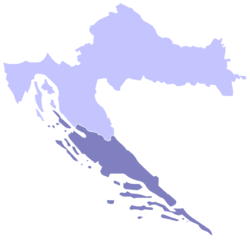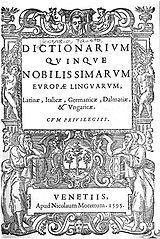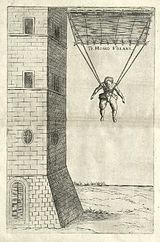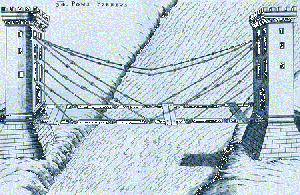Fausto Veranzio
This is about Wikipedia's article on Fausto Veranzio.
Fausto Veranzio is another article on Wikipedia that exhibits nationalistic editing. Fausto Veranzio (or Faust Vrančić in modern Croatian) [1][2] is an individual with a Dalmatian heritage.[3] He was historically a citizen of the Republic of Venice. [4]
Fausto was born in Šibenik [5][6] circa 1551 in Dalmatia, then a region of the Republic of Venice in todays modern Croatia. Dalmatia as a province, dates back to the Roman Empire [7] and is several centuries older than Croatia itself. In the 19th century Dalmatia became a province of the Austro-Hungarian Empire (Kingdom of Dalmatia). Dalmatian as a region has a very multicultural and multiethnic history.
Fausto was a brilliant scientist in his day and is noted for his invention of the parachute.
- Wikipedia stated on 3rd of October 2010. I have indicated the date because edits on Wikipedia are constant, some articles change daily:
| “ | ... he was a polymath and bishop from Croatia. | ” |
It must be stated as a fact that:
- Croatia itself has not been a sovereign independent state for nine centuries.
- Croatia only became a sovereign state 371 years after his death.
- Dalmatia was not part of Croatia until the middle of the 20th century.[8][9]
- Historically the term Croat became fully established as a constructed identity in the 19th century.
- Italian and Latin languages were then used extensively in Dalmatia. [10] The region also had a significant Dalmatian Italian ethnic population.[11]
Certain individuals (or organisations) are using Wikipedia's article for biased nationalistic propaganda. It otherwise tainted a perfectly good article on this unique individual. Some of the Croatian Wiki-Editors just can't separate ultra-extreme nationalistic propaganda from an unbiased historical perspective. Has Wikipedia become a gatheing place for such editors?
- John Van Antwerp Fine (Professor Emeritus of History at the University of Michigan) on Croatian History:
| “ | There is no justification to falsify history to support ethnic ambitions. The Croats and their Balkan neighbours have done this in a major way [12] | ” |
More on Fausto Veranzio
Fausto Veranzio in 1595 published (in Venice) a dictionary called "Dictionarium quinque nobilissimarum Europae linguarum: Latinae, Italicae, Germanicae, Dalmatiae & Ungaricae" (Dictionary of Five Most Noble European Languages: The Latin, Italian, German, Dalmatian and Hungarian). In his dictionary he referred to his native language [13] as Dalmatian. Front cover-link.
In 1617, (then sixty-five years old) he implemented his design and tested the parachute by jumping from St Mark's Campanile in Venice. The 17th century Brooklyn Tidal Mill in Long Island (New York), is based on his design and is one of the few still standing mills in the New York City area.
Today a Croatian Navy rescue ship bears the name Faust Vrančić.

Wiki Dairy Edit:
- Editor "Gun Powder Ma" on the 7 March 2011 returns "was a polymath and bishop from the Venetian Republic".
- Editor "Kebeta" on the 27 March 2011 (16:35) returns "was a polymath and bishop from Croatia".
- Editor "Gun Powder Ma" on the 27 March 2011 (19:23) returns "was a polymath and bishop from the Venetian Republic".
- Editor "DIREKTOR" on the 27 March 2011 (20:53) returns "was a polymath and bishop from Croatia".
- Editor "201.215.62.70" on the 27 March 2011 (21:42) returns "was a polymath and bishop from the Venetian Republic".
- Editor "DIREKTOR" on the 28 March 2011 (1:19) returns "was a polymath and bishop from Croatia".
- Editor "Gun Powder Ma" on the 28 March 2011 (22:35) returns "was a polymath and bishop from the Venetian Republic".
- Editor "Wustenfuchs " on the 3rd of April 2011 (18:22) "moved Fausto Veranzio to Faust Vrančić ".
- Editor "Gun Powder Ma" on the 4th of April 2011 (09:58) "moved Faust Vrančić to Fausto Veranzio over redirect: per Talk:Fausto Veranzio#Requested move redux"
- Editor "94.253.172.40" on the 24th May 2011 (20:03) writes "was a polymath and bishop from Dalmatia".
- Editor "Michael Bednarek" on the 1st June 2011 (7:48) writes "was a polymath and bishop from the Venetian Republic". Link
Wiki editing gone bad!
Strange doubling up happening in this encyclopaedic article.
- Note take from Wikipedia on the 4 April 2011:
| “ | He was the son of Mihael Vrančić, a Latin poet, and the nephew of Antun (Croatian: Antun Vrančić),[8] archbishop of Esztergom (1504–1573), a diplomat and a civil servant, who was in touch with Erasmus (1465–1536), Philipp Melanchthon (1497–1560), and Nikola Šubić Zrinski (1508–1566), who took Fausto with him during some of his travels trough Hungary and the Republic of Venice.[9]
He was the son of Michele Veranzio, a Latin poet, and the nephew of Antonio,[8] archbishop of Esztergom (1504–1573), a diplomat and a civil servant, who was in touch with Erasmus (1465–1536), Philipp Melanchthon (1497–1560), and Nikola Šubić Zrinski (1508–1566), who took Fausto with him during some of his travels trough Hungary and the Republic of Venice.[10] Fausto's mother was from the Berislavić family. His brother, Giovanni, died still young in battle.[8] |
” |
- Doubling up removed by Editor Vlatkojk (link)
Historical Perspectives on Dalmatia
Dalmatia is a region of Europe with a very multicultural and multiethnic history.It was named by the Romans after the Dalmatae (or Delmatae) Illyrian tribes [14] who inhabited the region.
Encyclopedia Britannica-Dalmatia
| “ |
|
” |
Note: "Ladislas, born 1377 in Naples Italy—died in 1414, Naples. Ladislas was the king of Naples, from 1386 claimant to the throne of Hungary from 1390, and prince of Taranto from 1406. He became a skilled political and military leader, taking advantage of power struggles on the Italian peninsula to greatly expand his kingdom and his power)." [17] Taken from Encyclopedia Britannica.
Andrew Archibald Paton
Andrew Archibald Paton (1811-1874) was a British diplomat and writer from the 19 century. In 1861 he wrote in his; Researches on the Danube and the Adriatic: Or, Contributions to the Modern:
- Signor Arneri from Korčula stated:
| “ | These three pears you see on the wall, said he, are the arms of my family. Perussich [18] was the name, when, in the earlier part of the fifteenth century, my ancestors built this palace; so that, you see.
I am Dalmatian. All the family, fathers, sons, and brothers, used to serve in the fleets of the Republic (Editors note: Republic of Venice) [19]; but the hero of our race was Arneri Perussich, whose statue you see there, who fought, bled, and died at the Siege of Candia, whose memory was honoured by the Republic, and whose surviving family was liberally pensioned; so his name of our race. We became Arneri, and ceased to be Perussich.'' [20] |
” |
| “ | ...the islands of Dalmatia owe much of their culture to the near vicinity of Venice and the more extensive use of the Italian language... [21] | ” |
Sir John Gardner Wilkinson
Sir John Gardner Wilkinson (1797 – 1875) was an English traveller, writer and pioneer Egyptologist of the 19th century. He is often referred to as "the Father of British Egyptology". He was in Dubrovnik (then called Ragusa) in 1848, he wrote in his; Dalmatia and Montenegro: With a Journey to Mostar in Herzegovina.Volume 1:
| “ | Italian is spoken in all the seaports of Dalmatia, but the language of the country is a dialect of the Slavonic, which alone is used by peasants in the interior.[22] | ” |
| “ | Their language though gradually falling into Venetianisms of the other Dalmatians towns, still retains some of that pure Italian idiom, for which was always noted. [23] | ” |
Maude Holbach (a 1910 travel guide)

"Dictionarivm qvinqve nobilissimarvm Evropæ lingvarvm, latinæ, italicæ, germanicæ, dalmatiæ, & vngaricæ"
(Venetiis: Apud Nicolaum Morettum, 1595) [24]
- Dalmatia-The Land Where East Meets West by Maude Holbach (a 1910 travel guide from COSIMO books and publications New York USA):
| “ | Two hundred years later that, is, early in the tenth century you might have heard Slavish and Latin spoken had you walked in the streets of Ragusa (Editors note: Dubrovnik),[25] just as you hear Slavish and Italian today; for as times of peace followed times of war, the Greek and Roman inhabitants of Rausium intermarried with the surrounding Slavs, and so a mixed race sprang up, a people apart from the rest of Dalmatia. [26] | ” |
See also
- Worst of Wikipedia
- The Wikipedia Point of View
- The Wikipedia Point of View/Activists
- Top 10 Reasons Not to Donate to Wikipedia
- Nationalistic Editing on Wikipedia
- Croatian Slavic Identity
- Dalmatian Italians
Notes and References
- ^ Pronounced in Croatian -Vranchich. The last ch is pronounced more softly.
- ^ Editors note: Recent DNA studies have stated that more than three quarters of today's Croatian men are the descendants of Europeans who inhabited Europe 13 000-20 000 years ago. The first primary source (factual-that its authenticity isn't disputed) to mention the Croatian-Hrvat identity in the Balkans was Duke Branimir (Latin: "Branimiro comite dux cruatorum cogitavit" c. 880 AD). Branimir was a Slav from Dalmatia.
- ^ Travels Into Dalmatia by Abbe Alberto Fortis (p121)
- ^ He's in the Paratroops Now by Alfred Day Rathbone (p172)
- ^ Ancient Engineers Inventions: Precursors of the Present by Cesare Rossi, Flavio Russo & Ferruccio Russo (p95)
- ^ Editors note: According to some sources the settlement of Sibenik was established by Croatian Slavs in the 11th century, and was given its name, Šibenik (the Š is pronounced sh ). The term Slav was first used by the Byzantines (i.e. Procopius-Byzantine scholar, Jordanes- 6th century Roman bureaucrat) and was recorded in the 6th century (cia. 550) in Greek (Σκλαβῖνοι-Sklabenoi). Later in Latin it was written Sclaveni. Slavic tribes invaded the region of Roman Dalmatia in the early Middle Ages. Prior to the arrival of the Slavs, Roman Dalmatia was mainly inhabited by a Roman Latin-Illyrian population. Šibenik was latter renamed Sebenico when in 1412 the city became part of the Republic of Venice (1412-1797). Its name was change to Šibenik by the Yugoslav regime in 1920.
- ^ The History of the Decline and Fall of the Roman Empire, Volume 1 by Edward Gibbon (p158)
- ^ Under the Treaty of Rapallo (in 1920 between Italy and the Kingdom of Serbia, Croatia & Slovenia.), Dalmatia became part of the Kingdom of Serbia, Croatia & Slovenia which was renamed the Kingdom of Yugoslavia in 1929. After World War II Dalmatia was divided between three republics of Communist Yugoslavia. Most of the territory went to Croatia. In 1991 the Republic of Croatia became independent.
- ^ Sections of the old Roman Dalmatian province were once part of the Kingdom of Croatia (925–1102).
- ^ The Early Beginnings of Formal Education - Vela Luka (beginnings of literacy and Lower Primary School 1857 – 1870):
- "Italian language was not only the official language in all public Dalmatian establishments, but also was the spoken language in a significant number of white-collar, civil service and merchant families in the cities and major markets within towns" (p.8 written in Croatian)
- ^ Concerning the Number of Italians/Pro-Italians in Dalmatia in the XIXth Century by Šime Peričić
- "It is true, then a small colony of Italians where in Sibenik, on the island of Korcula, Hvar and Vis, and other places of the province."
- ^ When Ethnicity did not Matter in the Balkans by John Van Antwerp Fine (p15)
- ^ Note: It is important to mention that Fausto Veranzio's native Šibenik language is based on the old Croatian Chakavian. It also has Italian from the Venetian dialect.
- ^ Medieval Greek"Dalmatae": Δαλμᾶται.
- ^ Note: Added Dalmatia as it is referring to the country/province Dalmatia .
- ^ Encyclopedia Britannica: Dalmatia
- ^ <templatestyles src="Module:Citation/CS1/styles.css"></templatestyles>"Encyclopedia Britannica: Ladislas". 2010. Retrieved 2010-10-06. Check date values in:
|date=(help) - ^ Otok Korčula (2nd edition) by Marinko Gjivoje, Zagreb 1969.
- According to Marinko Gjivoje: Perussich in modern Croatian is Piruzović. (p46-p47)
- The book outlines A-Z about the island of Korcula (Curzola), from traditions, history, culture to wildlife, politics & geography.
- ^ The Republic of Venice fought at the Siege of Candia
- ^ Researches on the Danube and the Adriatic: by Andrew Archibald Paton. Chapter 4. The Dalmatian Archipelago.(p164)
- ^ Researches on the Danube and the Adriatic, Volume 1 by Andrew Archibald Paton (p167)
- ^ Dalmatia and Montenegro: With a journey to Mostar in Herzegovina.Volume 1 by Sir John Gardner Wilkinson (p4)
- ^ Dalmatia and Montenegro: With a journey to Mostar in Herzegovina.Volume 1 by Sir John Gardner Wilkinson (p362)
- ^ www.library.yale.edu
- ^ The City of Dubrovnik's orginal name was Ragusa.
- ^ Dalmatia: The Land Where East Meets West by Maude Holbach (p121)
- "DALMATIA: The Land Where East Meets West is MAUDE M. HOLBACH's second book of travel in Eastern Europe. First published in 1910, this is an anthropological travel journal of an often-overlooked kingdom" Web site: www.cosimobooks.com
External links
More on nationalistic editing on Wikipedia.
- Francesco Patrizi: BEYOND NECESSITY- Francesco Patrizi Link
The case of Francesco Patrizi, the Venetian philosopher, is an illustration of the nationalistic warfare that is part of Wikipedia, and the inaccuracy, falsehood and bias that follows as a result.
Quote by Ocham-London, United Kingdom:
| “ | The problem becomes particularly acute in a place like Wikipedia, where the only intellectual interest - that is to say, no intellectual interest at all - lies simply in a nationalistic dispute, in this case between Italians and Croatians. | ” |
- Veranzio's, Machinae Novae (Venice 1595) contained designs of 56 different machines, tools, devices and technical concepts.Two variants of this work exist, one with the "Declaratio" in Latin and Italian. The book was latter written in German, French and Spanish. Veranzio died in Venice in 1617 and was buried in Dalmatia, near to his family's country house.
<sharethis />
Fausto Veranzio Faust Vrančić "[Country_Code" contains a listed "[" character as part of the property label and has therefore been classified as invalid. Dalmatia Sibenik Venice Dalmatian Language Worst of Wikipedia Dalmatian Venetian Roman Dalmatia Dalmatia Dalmatian History Republic of Venice




